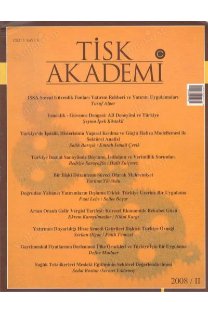Türkiye'de Uluslararası Sermaye Hareketleri Faiz İlişkisi: (1992-2005 Dönemi VAR Analizi)
Relation of International Capital Flows and the Interest In Turkey: (1992-2005 VAR Analysis)
___
- Altınkemer, Melike (1995), “Capital Inşows: The Turkish Case,” TCMB Discussion Papers, No:9601.
- Arias, E.Fernandez (1994), “The New Wave of Private Capital Inşows,” The World Bank Policy Research Working Paper, No.1312.
- Arias, E.Fernandez, P.J. Montiel (1999), “The Surge in Capital Inşows to Developing Countries: Prospects and Policy Response,” The World Bank Policy Research Working Paper, No.1473,
- Arslanoğlu, E. (2002), “The Structure and the Impact of Foreign Direct Investment in Turkey,” Marmara Üniversitesi İ.İ.B.F. Dergisi, Cilt. XVII, Sayı., ss.31-51.
- Akyüz, Y. and K. Boratav (2002), “The Making of the Turkish Financial Crisis” UNCTAD Discussion Papers, No.158.
- Berument Hakan ve N. Dinçer (2004), “Do Capital Şows Improve Macroeconomic Performance In Emerging Markets?: The Turkish Experience”. http://www.bilkent.edu.tr/~berument/ emft04.pdf, 28.05.2006
- Boratav, K. (2001), "2000-2001 Krizinde Sermaye Hareketleri,” İktisat-İşletme ve Finans Dergisi, Eylül No.186, ss.7-18.
- Büyükdeniz, Adnan (1991), Türkiye’de Faiz Politikaları, İstanbul Bilim ve Sanat Vakfı Bülteni.
- Calvo, G.A., L.Leiderman ve C.M. Reinhart (1993), “Capital Inşows to Latin America: The Role of External Factors,” IMF Staff Papers, Vol.40, pp.108-151.
- Calvo, G.A., L.Leiderman ve C.M.Reinhart (1996), “Inşows Of Capital To Developing Countries in The 1990s,” The Journal of Economic Perspectives, Vol.10, No.1, pp.123-139.
- Çeviş İsmail ve C. Kadılar (2001), “The Analysis Of The Short-Term Capital Movements By Using The VAR Model: The Case Of Turkey”. http://yunus.hacettepe.edu.tr/~kadilar/pakistan. pdf, 03.04.2006.
- Çimenoğlu, A. and N. Yentürk (2002), “Impacts Of International Capital Inşows On The Turkish Economy”. http://www.bilkent.edu.tr/ ~yeldanbs/Yazilar_Uye/YentürkCimen Ekim02.doc, 10.09.2005.
- Dickey, David A., Wayne A. Fuller (1979), “Distribution of the Estimates for Autoregressive Time Series with a Unit Root”, Journal of the American Statistical Association, Vol. 74, pp. 251-276.
- Dickey, D.A. ve W.A. Fuller (1981), “Likelihood Ratio Statistics for Autoregressive Time Series With A Unit Root,” Econometrica, Vol.49, No.4, pp.1057-1072.
- Enders, Walters ve C.W.J. Granger (1998), “Unit-Root Tests And Asymmetric Adjustment With An Example Using The Term Structure Of Interest Rates,” Journal Of Business and Economic Statistics, Vol.16, No.3, pp.304-311.
- Fry, Maxell J. (1997), “In Favour of Financial Liberalisation”, The Economic Journal, Vol.107, No.442, pp.754-770.
- Gujarati, Damador (2003), Basic Econometrics, Mc Graw-Hill, International Editions.
- Granger, C. (1969) “Investigating Causal Relations by Econometric Models and Cross-spectral Methods”, Econometrica, Vol.37, No.3, pp. 424-438.
- Günçavdı, Ö. ve S. Küçükçiftçi (2001), “Finansal Gelişme ve Finans Dışı Kesimin Finansal Girdi Kullanımı (1973-1990),” Çukurova Üniversitesi İktisadi ve İdari Bilimler Fakültesi Ekonometri Bölümü V. Ulusal Ekonometri Ve İstatistik Sempozyumu.
- Güneş, Mustafa ve R.Tulçal (2002), “Faiz Oranlarını Etkileyen Faktörlerin Regresyon Analizi İle Tespiti Üzerine Bir Uygulama,” Trakya Üniversitesi Bilimsel Araştırmalar Dergisi, Cilt.2, Sayı.1, ss.49-56.
- IMF (2006), International Financial Statistics, Database, www.mf.org
- İnsel, Aysu ve N.Sungur (2003), “Sermaye Akımlarının Temel Makroekonomik Göstergeler Üzerindeki Etkileri: Türkiye Örneği 1989:III-1999:IV,” Türkiye Ekonomi Kurumu, Tartışma Metni, 2003/8.
- Kaya, Yasemin Türker (1998), Sermaye Hareketleri ve Kısa Vadeli Sermaye Hareketlerinin Modellenmesi: Türkiye Örneği, Ankara: DPT.
- Krueger, A.O. (1987), Debt, Capital Şows, and LDC Growth, The American Economic Review, Vol.77, pp.159-164.
- Kula, Ferit (2003), “Uluslararası Sermaye Hareketlerinin Etkinliği: Türkiye Üzerine Gözlemler,” C.Ü. İktisadi ve İdari Bilimler Dergisi, Cilt.4, Sayı.2, pp.141-154.
- Kutlar, Aziz (2000), Ekonometrik Zaman Serileri, Ankara: Gazi Kitabevi.
- Mc Kinnon, R. I. (1973), Money and Capital in Economic Development, Washington D.C. Brookings Institution.
- Özgen, Ferhat Başkan ve Bülent Güloğlu (2004), “Türkiye’de İç Borçların İktisadi Etkilerinin VAR Tekniği İle Analizi,” METU Studies in Development Vol.31, ss.93-114.
- Petroulas, Paulos (2004), “Capital Controls On Short-Term Inşows and Unstable Financial Markets”, Stockholm University http:// www.ne.su.se/research/seminars/pdf/ 040323 2.pdf, 21.05.2006.
- Sancak, C. (2002), “Financial Liberalization and Real Investment: Evidence from Turkish Firms,” IMF Working Papers, No:02/100.
- Tarı, Recep (2005), Ekonometri, Kocaeli Üniversitesi Yayınları, No.172.
- TCMB (2006), Elektronik Veri Dağıtım Sistemi, www.tcmb.gov.tr.
- Uygur, Ercan (2001), “Krizden Krize Türkiye: 2000 Kasım ve 2001 fiubat Krizleri,” Türkiye Ekonomi Kurumu, Tartışma Metni, No: 2001/01, Ankara.
- Ülengin, B. and Nurhan Yentürk (2001), “Impacts of Capital Şows on Aggregate Spending Categories: The Case of Turkey,” Applied Economics, Vol. 33, pp.1321-1328.
- Ying, Yung-Hsiang ve Y.Kim (2001), “An Empirical Analysis on Capital Şows: The Case of Korea and Mexico,” Southern Economic Journal, Vol.67, No.4, pp.954-968.
- ISSN: 1306-6757
- Yayın Aralığı: 2
- Başlangıç: 2006
- Yayıncı: Türkiye Isveren Sendikalari Konfederasyonu
Eşitlik Kurumu: Bir Alternatif Uyuşmazlık Çözüm Modeli
İşyerinde Psikolojik Taciz (Mobbing) ve Hukuki Sonuçları
Türkiye'de Uluslararası Sermaye Hareketleri Faiz İlişkisi: (1992-2005 Dönemi VAR Analizi)
Türkiye'de Çocuk ve Yoksulluğu: Ölçüm Yöntemleri ve Yoksulluğun Belirleyicileri
Reklam Planlaması ve Etkinliğinin Ölçülmesi Üzerine Bir İnceleme
Türkiye'de İkiz Açıklar Hipotezi: 1989-2005
